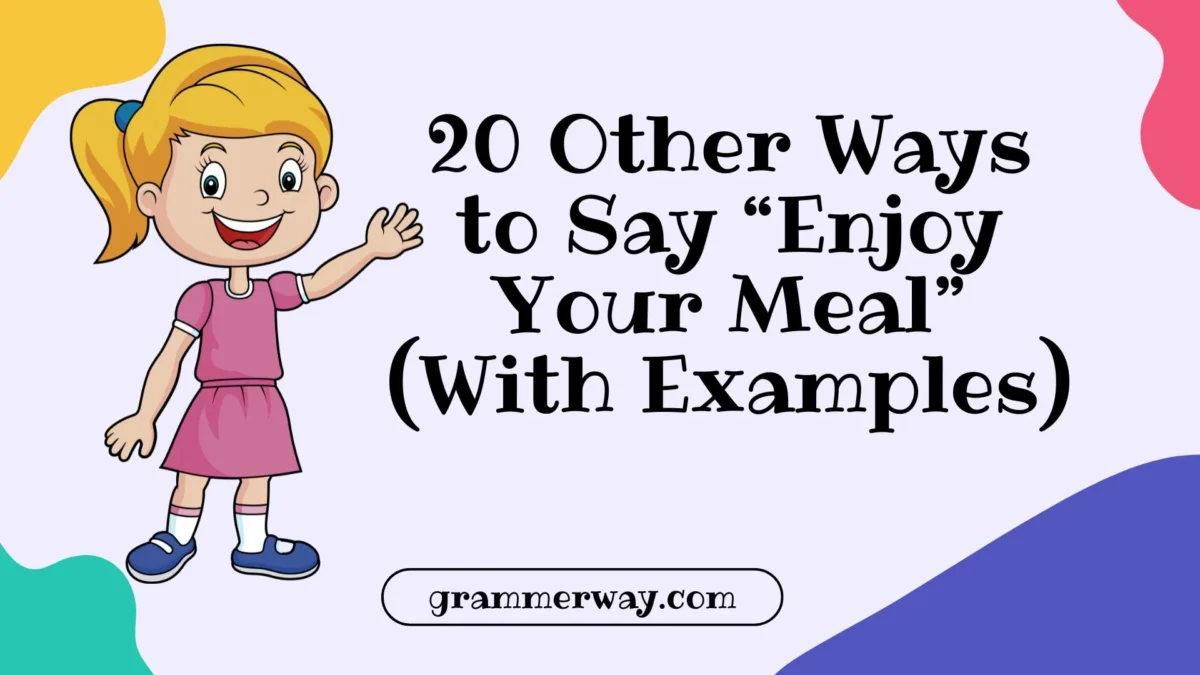When we say “Enjoy your meal”, it’s more than just about food — it’s about showing warmth, care, and thoughtfulness. Sometimes, though, we want to say it in a different way that feels personal, meaningful, or even fun. Finding the right words helps us connect better with others, whether it’s in a family dinner, a professional lunch, or a friendly chat.
In this guide, you’ll discover 20 unique alternatives to “Enjoy your meal,” each with its meaning, examples, and the best situations to use them.
What Does “Enjoy Your Meal” Mean?
The phrase “Enjoy your meal” is a polite way of wishing someone a pleasant eating experience. It’s commonly used in restaurants, homes, and even work gatherings. At its core, it’s a way to show hospitality, kindness, and good wishes toward someone before they eat.
Is It Professional/Polite to Say “Enjoy Your Meal”?
Yes, saying “Enjoy your meal” is both professional and polite. In formal settings, such as business lunches or client dinners, it creates a warm and respectful atmosphere. In casual settings, it feels friendly and natural. The key is in tone and timing—a warm smile and sincere delivery make the phrase more genuine.
Synonyms For Enjoy Your Meal
- Bon Appétit
- Dig In
- Happy Eating
- Savor Every Bite
- Hope It Tastes Good
- Have a Delicious Meal
- Chow Down
- Feast Well
- May Your Meal Be Wonderful
- Tuck In
- Hope You Love It
- Satisfy Your Cravings
- Take a Bite and Enjoy
- Enjoy Every Flavor
- Eat Heartily
- Make the Most of It
- Hope It Fills You Up
- Relish Your Food
- Eat to Your Heart’s Content
- Treat Yourself
1. Bon Appétit
Meaning: A French phrase often used worldwide to wish someone a delightful meal. It feels classy and elegant.
Scenario: Great for formal dinners, restaurants, or when you want to add a touch of sophistication.
Examples:
- “Dinner is served—bon appétit!”
- “Here’s your plate, bon appétit.”
- “That smells amazing, bon appétit.”
- “Enjoy the flavors, bon appétit.”
- “Cheers, everyone—bon appétit.”
Tone: Elegant, polished, and warm.
Explanation: This phrase makes your message feel more cultured and refined, especially in formal or semi-formal situations.
2. Dig In
Meaning: A casual and enthusiastic way to invite someone to start eating right away, especially when food looks too good to wait.
Scenario: Perfect for family dinners, barbecues, and casual gatherings.
Examples:
- “The pizza’s hot—dig in!”
- “Food’s ready, everyone—dig in.”
- “Don’t be shy, dig in.”
- “Looks delicious, let’s dig in.”
- “Plenty to go around—dig in.”
Tone: Energetic, playful, and friendly.
Explanation: Using this phrase shows excitement and joy about sharing food. It’s informal and creates a relaxed, welcoming atmosphere.
3. Happy Eating
Meaning: A cheerful way of wishing someone joy while they eat. It feels lighthearted and sweet.
Scenario: Works well with kids, family members, or in casual chats.
Examples:
- “Here’s your sandwich—happy eating!”
- “That looks so yummy, happy eating.”
- “Fresh out of the oven, happy eating.”
- “I hope you love it—happy eating.”
- “Dinner is served—happy eating.”
Tone: Cheerful, caring, and casual.
Explanation: This phrase adds a touch of kindness and playfulness, making mealtimes feel warm and pleasant.
4. Savor Every Bite
Meaning: Encourages someone to eat slowly and truly enjoy the flavors.
Scenario: Works best when the food is homemade, gourmet, or prepared with care.
Examples:
- “This took hours to prepare, so savor every bite.”
- “It’s rich and flavorful—savor every bite.”
- “You’ll love this recipe—savor every bite.”
- “A little treat for you—savor every bite.”
- “This dish is special, so savor every bite.”
Tone: Thoughtful, gentle, and appreciative.
Explanation: This phrase helps highlight the value and effort behind the meal, making it feel more special and mindful.
5. Hope It Tastes Good
Meaning: A kind way of expressing care, often used when someone tries your cooking.
Scenario: Perfect when you’ve prepared a dish yourself and want to wish them a good experience.
Examples:
- “I made this for you—hope it tastes good.”
- “Here’s my new recipe—hope it tastes good.”
- “This is my first attempt, hope it tastes good.”
- “Fresh from the oven—hope it tastes good.”
- “I tried something different—hope it tastes good.”
Tone: Caring, humble, and sincere.
Explanation: This phrase shows thoughtfulness and a bit of vulnerability, making it more personal and heartfelt.
6. Have a Delicious Meal
Meaning: A friendly and uplifting way to wish someone an enjoyable dining experience.
Scenario: Great for both casual and polite settings, especially when wishing friends or colleagues well.
Examples:
- “Dinner’s ready—have a delicious meal.”
- “Take your time and have a delicious meal.”
- “We ordered your favorite—have a delicious meal.”
- “Bon voyage dinner—have a delicious meal.”
- “Here’s your plate, have a delicious meal.”
Tone: Warm, positive, and polite.
Explanation: It’s a versatile phrase that works in many contexts, making it a safe and thoughtful option.
7. Chow Down
Meaning: A fun and informal way of telling someone to start eating.
Scenario: Ideal for friendly get-togethers, casual meals, or playful conversation.
Examples:
- “Pizza night—chow down!”
- “Looks tasty—time to chow down.”
- “We’ve got plenty, so chow down.”
- “Game night snacks—chow down.”
- “It’s all yours—chow down.”
Tone: Playful, lighthearted, and casual.
Explanation: This phrase creates a fun, easygoing vibe, often making mealtimes feel more relaxed and cheerful.
8. Feast Well
Meaning: Wishing someone a hearty and satisfying meal, especially when the food is plentiful.
Scenario: Great for festive gatherings, holiday meals, or big celebrations.
Examples:
- “Happy holidays—feast well.”
- “It’s a big spread, so feast well.”
- “Family reunion dinner—feast well.”
- “Enjoy the banquet—feast well.”
- “Plenty to enjoy—feast well.”
Tone: Festive, joyful, and generous.
Explanation: The phrase adds a sense of abundance and celebration, perfect for special occasions.
9. May Your Meal Be Wonderful
Meaning: A more poetic and kind-hearted wish for someone’s meal.
Scenario: Ideal for warm, sincere conversations, whether formal or informal.
Examples:
- “Here’s your plate—may your meal be wonderful.”
- “Enjoy dinner tonight—may your meal be wonderful.”
- “From my kitchen to you—may your meal be wonderful.”
- “This is made with love—may your meal be wonderful.”
- “Whatever you’re eating, may your meal be wonderful.”
Tone: Gentle, heartfelt, and warm.
Explanation: It feels a little more thoughtful and poetic, making it perfect when you want to show genuine care.
10. Tuck In
Meaning: A British phrase inviting someone to begin eating with enthusiasm.
Scenario: Great for friendly, homely settings or casual mealtime conversations.
Examples:
- “Dinner’s served—tuck in!”
- “Fresh and hot, so tuck in.”
- “No need to wait, everyone—tuck in.”
- “That stew smells great—tuck in.”
- “It’s all ready—tuck in.”
Tone: Cheerful, inviting, and casual.
Explanation: This phrase makes mealtime feel warm, family-like, and welcoming, often used in a cozy setting.
11. Hope You Love It
Meaning: A warm way of expressing care when offering food, showing you want them to enjoy it.
Scenario: Perfect for when you cook or recommend a meal.
Examples:
- “I made this dish—hope you love it.”
- “My favorite recipe—hope you love it.”
- “This one’s special—hope you love it.”
- “I tried something new—hope you love it.”
- “It’s all for you—hope you love it.”
Tone: Caring, affectionate, and sincere.
Explanation: This phrase reflects personal connection and genuine thoughtfulness, making it especially good in close relationships.
12. Satisfy Your Cravings
Meaning: Encourages someone to enjoy food in a fulfilling way, especially when it’s indulgent.
Scenario: Works well when offering snacks, desserts, or favorite comfort foods.
Examples:
- “Fresh cookies—satisfy your cravings.”
- “You’ve been waiting all day—satisfy your cravings.”
- “Pizza night—satisfy your cravings.”
- “This dessert is for you—satisfy your cravings.”
- “Take a break and satisfy your cravings.”
Tone: Fun, indulgent, and casual.
Explanation: It makes eating sound like a rewarding and enjoyable experience, perfect for treats or comfort foods.
13. Take a Bite and Enjoy
Meaning: Invites someone to taste the food with pleasure.
Scenario: Great for moments when introducing new dishes or recipes.
Examples:
- “Try this new pasta—take a bite and enjoy.”
- “Homemade brownies—take a bite and enjoy.”
- “First spoonful—take a bite and enjoy.”
- “Try it while it’s warm—take a bite and enjoy.”
- “One bite is all it takes—take a bite and enjoy.”
Tone: Light, inviting, and friendly.
Explanation: This phrase gently encourages tasting and conveys a positive mealtime spirit.
14. Enjoy Every Flavor
Meaning: Suggests appreciating the variety of tastes in a meal.
Scenario: Works well with flavorful dishes, multi-course meals, or cultural foods.
Examples:
- “This curry is full of spices—enjoy every flavor.”
- “Lots of sides to try—enjoy every flavor.”
- “The sauce is rich—enjoy every flavor.”
- “It’s all homemade—enjoy every flavor.”
- “From sweet to savory—enjoy every flavor.”
Tone: Appreciative, thoughtful, and warm.
Explanation: Encourages mindful eating, showing care for the richness of the meal.
15. Eat Heartily
Meaning: Wishing someone a satisfying and nourishing meal.
Scenario: Great for family meals or hearty dishes.
Examples:
- “It’s stew night—eat heartily.”
- “Cold evening calls for soup—eat heartily.”
- “Plenty to go around—eat heartily.”
- “Here’s a big portion—eat heartily.”
- “Dinner is served—eat heartily.”
Tone: Comforting, generous, and warm.
Explanation: This phrase highlights nourishment and satisfaction, making it great for homely settings.
16. Make the Most of It
Meaning: Encourages someone to enjoy their food fully, appreciating the moment.
Scenario: Works in casual or reflective situations, especially with special meals.
Examples:
- “It’s your favorite dish—make the most of it.”
- “We don’t have this often—make the most of it.”
- “Enjoy this treat—make the most of it.”
- “This is a rare recipe—make the most of it.”
- “Dinner out tonight—make the most of it.”
Tone: Reflective, caring, and warm.
Explanation: Reminds people to value the moment and the meal, making it more meaningful.
17. Hope It Fills You Up
Meaning: A simple and caring phrase that wishes the meal to be both satisfying and nourishing.
Scenario: Good for when serving hearty, filling dishes.
Examples:
- “Big breakfast—hope it fills you up.”
- “Plenty of rice—hope it fills you up.”
- “This stew should do it—hope it fills you up.”
- “Long day ahead—hope it fills you up.”
- “I made extra—hope it fills you up.”
Tone: Practical, caring, and down-to-earth.
Explanation: It shows consideration for someone’s needs, especially when they’re hungry or need energy.
18. Relish Your Food
Meaning: Encourages someone to take deep pleasure in their meal.
Scenario: Ideal for delicious, flavorful, or special foods.
Examples:
- “That’s your favorite—relish your food.”
- “The flavors are rich—relish your food.”
- “Take your time—relish your food.”
- “Fresh and homemade—relish your food.”
- “Enjoy the details—relish your food.”
Tone: Appreciative, thoughtful, and slightly formal.
Explanation: This phrase inspires a deeper appreciation for food, making it sound more meaningful.
19. Eat to Your Heart’s Content
Meaning: Wishing someone the joy of eating as much as they like.
Scenario: Works best in generous or abundant food settings.
Examples:
- “Plenty to enjoy—eat to your heart’s content.”
- “It’s a buffet—eat to your heart’s content.”
- “Don’t hold back—eat to your heart’s content.”
- “Big feast tonight—eat to your heart’s content.”
- “Enjoy it all—eat to your heart’s content.”
Tone: Generous, joyful, and warm.
Explanation: This phrase shows hospitality and abundance, making guests feel welcomed.
20. Treat Yourself
Meaning: Suggests enjoying the meal as a little act of self-care or indulgence.
Scenario: Perfect for desserts, comfort food, or something special.
Examples:
- “Here’s a slice of cake—treat yourself.”
- “Long day? Treat yourself.”
- “You deserve this—treat yourself.”
- “Chocolate’s waiting—treat yourself.”
- “This is your favorite—treat yourself.”
Tone: Encouraging, kind, and indulgent.
Explanation: Reminds people that eating can be a form of joy and self-kindness, especially when it’s something special.
Conclusion
Finding other ways to say “enjoy your meal” can bring more warmth, variety, and personality to your words. Whether you’re at a formal dinner, a family gathering, or a casual hangout, choosing the right phrase makes your message feel more personal and meaningful. From the elegant “bon appétit” to the playful “dig in” or the caring “hope you love it”, each expression carries a unique tone.
The next time you’re about to serve food or share a meal with someone, try using one of these alternatives. A simple phrase can make the moment feel special, memorable, and full of care.
FAQs
1. What can I say instead of “enjoy your meal” in a formal setting?
You can use “bon appétit,” “have a delicious meal,” or “may your meal be wonderful.” These sound polite and professional while still being warm.
2. Is it rude not to say anything before someone eats?
Not at all! But offering a kind phrase such as “happy eating” or “tuck in” adds a thoughtful touch and shows care.
3. Which alternatives are best for kids?
Lighthearted ones like “happy eating,” “dig in,” or “chow down” are fun and easy for kids to enjoy.
4. How do I make “enjoy your meal” sound more personal?
Add warmth with phrases like “hope you love it,” “treat yourself,” or “savor every bite.” Personal words make it more heartfelt.
5. Can I use these alternatives in text messages?
Yes! Many of them, like “treat yourself,” “hope it tastes good,” or “enjoy every flavor,” work perfectly in casual messages or notes.







Leave a Comment